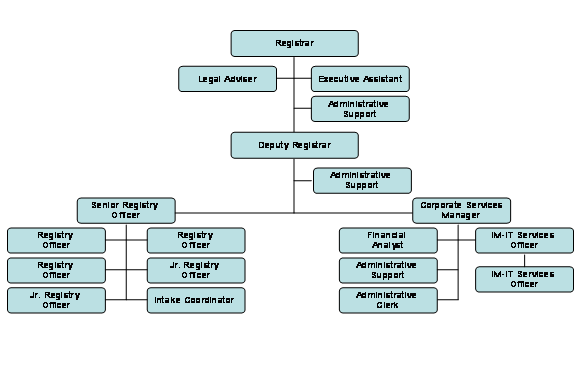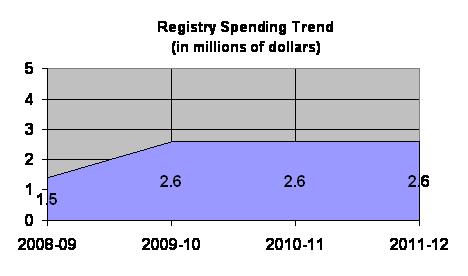Common menu bar links
Breadcrumb Trail
ARCHIVED - Registry of the Specific Claims Tribunal
 This page has been archived.
This page has been archived.
Archived Content
Information identified as archived on the Web is for reference, research or recordkeeping purposes. It has not been altered or updated after the date of archiving. Web pages that are archived on the Web are not subject to the Government of Canada Web Standards. As per the Communications Policy of the Government of Canada, you can request alternate formats on the "Contact Us" page.
DEPUTY HEAD'S MESSAGE

Since my appointment as the Deputy Head and Registrar of the Specific Claims Tribunal on October 16, 2008, we have been busy creating the structures and processes required for the success of the Registry and the Tribunal. Our vision for the next year is to finalize all start-up activities, which includes development of an electronic registry; implementation of a management accountability framework; implementation of an integrated human resource and business plan; and constituency outreach. With these essential elements in place, the Tribunal will be in a position to hear its first cases in 2009.
I am pleased to present the 2009–2010 Report on Plans and Priorities for the Registry of the Specific Claims Tribunal. I trust that the information contained within will provide Parliament and Canadians with consistent, comprehensive, balanced, and reliable information on the Registry's priorities, expenditure plans and expected results over the next three fiscal years.
[Original signed by Wayne D. Garnons-Williams]
Wayne D. Garnons-Williams
Deputy Head and Registrar
Specific Claims Tribunal
SECTION I: OVERVIEW OF THE REGISTRY
A) RAISON D'ÊTRE AND RESPONSIBILITIES
The Registry of the Specific Claims Tribunal is constituted under the Specific Claims Tribunal Act (which came into force on October 16, 2008) to manage the administrative affairs of the Specific Claims Tribunal. The Tribunal is an adjudicative body with the express mandate of deciding First Nations' specific claims including breaches of treaties, fraud, illegal dispositions, or inadequate compensation, related to reserve lands.
Although the Registry's offices are located in Ottawa, it provides services to the judiciary of the Tribunal and all interested First Nations and the Crown. The Registry provides administrative services to the judiciary, the legal profession, and the public. These services support the resolution of cases across Canada fairly, without delay, and with an efficient, effective, and economic application of resources. More specifically, the Registry is responsible for processing of specific claims, scheduling hearings, processing warrants, subpoenas, and writs, case and records management, systems management, provision of services in both official languages, and supporting judges of the Tribunal.
Treaty disputes have been an ongoing source of tension between First Nations and the federal government, and the Specific Claims Tribunal Act was developed jointly by the Assembly of First Nations and the Government of Canada as a means to quickly and fairly resolve most outstanding treaty grievances. This partnership is now extended to the development of recommendations related to the Tribunal's rules of practices and procedures.
Cooperation between First Nations and the Crown in the development, design, and drafting of the Specific Claims Tribunal Act represents a paradigm shift in relations, toward an overarching theme of respect for First Nations culture, traditions, and philosophy. It is a reminder of the importance and potential benefit that can accrue in seeking Aboriginal solutions to Aboriginal challenges.
These recent successes operate in a larger treaty dispute context of past broken promises, false starts, and mistrust. The Registry must ensure that administration of the Tribunal provides a process and results that are not only legitimate, but also perceived by First Nations as legitimate. To accomplish this, the Registry must respect and embrace Aboriginal cultural traditions in the administration of Tribunal operations nationally, and must work cooperatively with stakeholders to ensure that the spirit and intent of the legislation is fulfilled.
B) ORGANIZATION CHART OF THE REGISTRY

C) STRATEGIC OUTCOME: EFFICIENT ADMINISTRATION OF THE SPECIFIC CLAIMS TRIBUNAL
The sole strategic outcome for the Registry as approved by Treasury Board is the efficient administration of the Specific Claims Tribunal, which will be supported by program activity related to registry services.
The long-term benefit for Canadians will be the efficient and effective resolution of outstanding specific claims, with the potential for increased reconciliation and improved relationships amongst First Nations, the Government of Canada, and Canadians. The efficient operation of the Tribunal will create value for Canadians by saving costs associated with traditional Superior Court litigation and negotiations. Monetary awards determined by the judiciary of the Tribunal to successful claimants will provide First Nations with capital that may then be reinvested in their communities, contributing to the on-going prosperity of First Nations peoples in Canada.
D) PROGRAM ACTIVITY ARCHITECTURE
|
STRATEGIC OUTCOME: EFFICIENT ADMINISTRATION OF THE SPECIFIC CLAIMS TRIBUNAL |
||
|---|---|---|
|
PROGRAM ACTIVITY: REGISTRY SERVICES (Facilitate timely access to the Specific Claims Tribunal through client service, quality of advice, efficient and timely processing, and unbiased service delivery.) |
PROGRAM PRIORITIES |
DESCRIPTION |
|
Develop and implement an electronic registry. |
Effective case management is critical for quick resolution of claims and for overcoming logistic barriers to national access to the Registry. |
|
|
Integrated human resouce and business plan. |
Essential to operating the Registry in a cost-effective, fair, and transparent manner. |
|
|
Renovation of Registry offices and construction of culturally sensitive multipurpose room. |
Renovated offices to fit logistical needs of the Registry and Tribunal. Multipurpose room will provide digital hub to administer national activities of the Tribunal and a setting that is respectful of Aboriginal culture. |
|
|
Public awareness strategy and campaign. |
The focus of public awareness is the legal community, which represents First Nations in the resolution of treaty disputes, and which provides First Nations communities and the public with transparent electronic access to Registry records. |
|
|
Develop and measure customer service standards |
Customer service standards and evaluation provide objective criteria to ensure that the needs of clients and the public are being met. |
|
|
LINK TO GOVERNMENT OF CANADA OUTCOMES: SOCIAL AFFAIRS — A VIBRANT CANADIAN CULTURE AND HERITAGE |
||
E) PLANNING SUMMARY
Financial and Human Resources
| 2009-2010 | 2010-2011 | 2011-2012 | |
|---|---|---|---|
|
Financial Resources |
2.6 |
2.6 |
2.6 |
|
Human Resources (FTEs) |
19 |
19 |
19 |
Planning Summary Table
|
STRATEGIC OUTCOME: EFFICIENT ADMINISTRATION OF THE SPECIFIC CLAIMS TRIBUNAL |
|||||
|---|---|---|---|---|---|
|
PERFORMANCE INDICATORS • Processing and hearing claims, while meeting the reasonable needs of parties, the judiciary, and the public, within allocated budget. |
TARGETS • Administer Registry within financial allocation. |
||||
|
PROGRAM ACTIVITY |
FORECAST SPENDING 2008–2009 (in millions of dollars) |
PLANNED SPENDING |
ALIGNMENT TO GOVERNMENT OF CANADA OUTCOME |
||
|
2009–2010 |
2010–2011 |
2011–2012 |
|||
|
REGISTRY SERVICES (Facilitate timely access to the Specific Claims Tribunal through client service, quality of advice, efficient and timely processing, and unbiased service delivery.) |
1.5 |
2.6 |
2.6 |
2.6 |
Social Affairs: A Vibrant Canadian Culture and Heritage |
Contribution and Linkages of Priorities to the Strategic Outcomes
| MANAGEMENT PRIORITIES | TYPE | STRATEGIC OUTCOMES | DESCRIPTION |
|---|---|---|---|
|
Develop and implement an integrated human resources and business plan, with associated policies. |
New |
Efficient administration of the Specific Claims Tribunal |
Integrated human resource and business plan will clarify business processes, while ensuring that qualified human resources are retained, through implementation of succession plans, development plans, professional development plans, and performance plans. — Priority will be met by implementing best practices in tribunal administration and conducting recruitment, training, and team-building activities. |
|
Development of work descriptions, classification of levels and staffing of qualified people. |
Clear and concise work descriptions will ensure that processing of claims and delivery of services occurs in an efficient and effective manner. Qualified staff will provide effective Registry operations. Management's respect for the spirit and intent of the Official Languages Act and Treasury Board Employment Equity policies will encourage qualified, bilingual Aboriginal candidates to apply for positions at the Registry. —Priority will be met by contracting for the development and drafting of job descriptions, employment posters, and support staffing activities to meet operational needs. |
| OPERATIONAL PRIORITIES | TYPE | STRATEGIC OUTCOMES | DESCRIPTION |
|---|---|---|---|
|
Develop and implement an electronic registry. |
New |
Efficient administration of the Specific Claims Tribunal |
Will allow clients to file documents electronically through the Registry website. Will allow for the efficient processing of claims across Canada, through the reduction of resources dedicated to printing, binding, and delivery of documents. Will allow Tribunal judges immediate access to Registry operations from their respective chambers across Canada, and facilitate remote administration of Tribunal proceedings. Will provide an efficient way to track cases and case trends, thereby allowing issues to be identified and addressed quickly. Will result in improved and timely access to information by both internal and external clients, and will facilitate timely user access to the judicial process. —Priority will be met by contracting for the development and implementation of software and hardware case management systems that meets operational needs. |
|
Complete renovations of Registry offices, including culturally sensitive multipurpose room. |
Will ensure that business operations are carried out efficiently. Will provide digital hub to administer national activities of the Tribunal and a setting that is respectful of Aboriginal cultures. —Priority will be met by completing renovation of offices and a culturally sensitive multipurpose room that meets the business needs of the Registry, the judiciary, and our clients. |
||
|
Assist the judiciary of the Tribunal in drafting rules of practice and procedure. |
Tribunal rules are a core consideration in expediting claims. Efficient rules will result in timely resolution of claims. —Priority will be met by exploring and implementing fact-finding best practices, through processes that respect both the spirit and intent of collaborative recommendations by the Assembly of First Nations and the Department of Justice. |
||
|
Make the Canadian public at large aware of the Tribunal's services and results. Promote awareness among the stakeholder groups of the Registry's operations and procedures. |
Public awareness will highlight results for Canadians, and will provide transparency in the Registry's operations. A public presence for the Tribunal will foster understanding of federal treaty relations among the Canadian public at large. Awareness of the Tribunal and its process will provide claimants and their legal counsel with knowledge that enables them to bring their claims to the Tribunal. — Priority will be met by developing a user-friendly, informative, interactive Web page; participating in media opportunities where appropriate; attending and participating in conferences; conducting outreach; and creating communications materials. |
F) RISK ANALYSIS
Operating Environment
In 1973, the Government of Canada introduced its Specific Claims Policy to resolve First Nations' specific claims. The policy was revisited in 1982, to include consideration of specific claims based on inadequate compensation for taking or damaging reserve land, as well as situations of fraud by government agents regarding reserve lands. These revisions also focused on the process and guidelines for submitting specific claims.
The Specific Claims Policy was revised again in 1991. The new revision included removal of the bar on pre-confederation specific claims and establishment of the Indian Specific Claims Commission as a temporary measure until the Government of Canada could formulate legislation to create an independent entity with binding powers. In light of the legislation creating this independent entity (the Specific Claims Tribunal), the Indian Specific Claims Commission will conclude their activities by March 31, 2009.
Notwithstanding the Tribunal's judicial mandate, the specific claims administrative process, as managed by the Department of Indian and Northern Affairs Canada, has four main phases: review and assessment; determination of validity; acceptance or rejection; and negotiations. It is estimated that there are 785 specific claims, with approximately 580 at the assessment stage, and 58 in negotiation.
The Specific Claims Tribunal Act creates strict timelines with respect to the assessment and negotiation of specific claims. The Government of Canada will have three years to communicate acceptance or rejection of a specific claim. If accepted for negotiation, the parties have three years from notification to resolve the claim. If after three years of negotiation the claim is not resolved, a First Nation may file a claim with the Tribunal.
All new specific claims submissions must meet a minimum standard with respect to the type of information and manner of presentation required to file with the Government of Canada.
Risks
There are a number of risks inherent to the establishment of a new institution. Specifically for the Registry, there is the risk of substantial delay in the renovation of the Registry's offices, including the culturally sensitive multipurpose room of the development and implementation of an electronic registry. These risks can be mitigated through tendered contracts with qualified service providers who have proven track records for on-time delivery.
Another risk that could impact the effectiveness of the Registry is a set of rules of practice and procedure that do not meet the needs of either the Crown or First Nations.Such rules may not prove to be efficient or result in quick resolution of hearings. This risk can be mitigated through a collaborative (First Nations/Crown) user based rules designing team; the extensive study of international best practices in other fact-finding tribunals, commissions, or courts as well as through implementation of an innovative electronic registry.
External human resources risk factors could include the potential lack of qualified labour knowledgeable enough to carry out work at the Registry in a culturally sensitive manner. Contributing factors could include lack of advancement opportunities within the organization due to its small size; lack of educated and skilled labour; the highly specialized nature of the work, and the demographically large workforce eligible for retirement within the next ten years.
Manifestation of risk would lead to delays in the Tribunal's ability to receive and process claims, and could lead to the breakdown of efficient business operations. Mitigation of risk could include development and delivery of orientation and training programs to accelerate the process of knowledge transfer, corporate succession planning, bridging of new post-secondary graduates into introductory Registry positions, and the development of internal career evaluation and advancement mechanisms, including learning assignments and interdepartmental exchanges among similar federal boards, commissions, and tribunals.
Claims will be brought to the Tribunal on the initiative of First Nations, and there are other avenues that they may use for redress. The risk is that there may be substantially more, or substantially fewer, claims brought to the Tribunal than projected. More claims may result in significant delays, while fewer claims may result in the unnecessary expenditure of resources. In order to respond effectively to either scenario, the Registry will closely monitor the progress of potential claims and attempt to ascertain which of them may come before the Tribunal. An accurate forecast of caseload will require an excellent working relationship with stakeholders.
The last identifiable risk is the potential that First Nations will come to view the Tribunal as an agent of government, or that the Crown will view the Tribunal as favouring First Nations, thereby exhibiting an appearance of being unfair and/or biased.It is critical that the Registry and the Tribunal implement procedures that are “at arms length,” so as to protect and safeguard their independence.
G) EXPENDITURE PROFILE

The Registry came into existence when its constituting legislation came into force on October 16, 2008. The $1.5 million for the 2008–2009 fiscal year reflects the lack of a full year of operation and covers partial start-up expenditures and a small portion of salary dollars. Once the Registry is in full operation, projected expenditures may need to be revised to reflect either the need for additional operating funds or potential budget surpluses.
H) VOTED AND STATUTORY ITEMS
| VOTE NUMBER | TRUNCATED VOTE | MAIN ESTIMATES (in millions of dollars) |
|
|---|---|---|---|
|
2008–2009[1] |
2009–2010 |
||
|
55 |
Program Expenditures |
0 |
2.4 |
|
(S) |
Contributions to employee benefit plans |
0 |
0.2 |
|
|
TOTAL |
0 |
2.6 |
